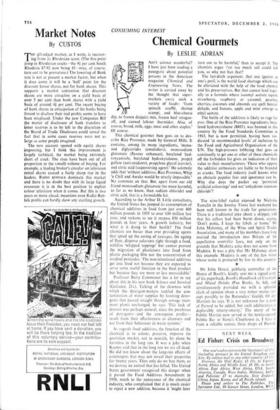Chemical Gourmets
CONSUMING INTEREST
By LESLIE ADRIAN
This chemical gourmet then goes on to des- cribe Rice Provence, made by General Mills. It contains, among its many ingredients, 'mono- and diglycerides (emulsifiers), monosodium glutamate (flavour enhancer), butylated hyd- roxyanisole, butylated hydroxytoluene, propyl gallate (anti-oxidants), propylene glycol (carrier), and citric acid (sequestering agent).' He solemnly adds that 'without additives, Rice Provence, Whip 'n Chill and Awake would be utterly impossible.' No comment on that. But, apart from our old friend monosodium glutamate (no more harmful, as far as we know, than sodium chloride) and citric acid, that is a formidable list.
According to the Arthur D. Little consultants, the United States has jumped its consumption of chemical additives in food from just over 400 million pounds in 1955 to over 650 million last year, and reckons to see it surpass 850 million pounds in four years. A growth industry, but what is it doing to their health? The food chemists are busier than ever providing agents that speed up the curing of sausages, the ageing of flour, disperse colorants right through a food, stabilise 'whipped toppings' but cannot prevent the migration of plasticisers into food from plastic packaging film nor the concentration of residual pesticides. 'The non-intentional additives get into food not because they are expected to serve some useful function in the final product but because they are more or less unavoidable.' Professor Barry Commoner has a lot to say about this in his new book Science and Survival (Gollancz, 21s.). Talking of the slowness with which the detergent-makers tackled the con- tamination of water supplies by foaming deter- gents that passed straight through sewage treat- ment plants unchanged, he says 'This lack of interest was perhaps natural, since the purchases of detergents—and the consequent profits— result from their effectiveness as cleansers and not from their behaviour in waste systems.'
As regards food additives, the function of the chemical is to colour, preserve, improve (in quotation marks), not to nourish, let alone be harmless in the long run. It was a joke when Keynes said that in the long run we are all dead. He did not know about the long-run effects of carcinogens that may not reveal their properties for twenty years. Then only do we ban them, as we destroy an animal that has killed. The United States government recognised this danger when it passed the Food Additives Amendment in 1958, much to the annoyance of the chemical industry, who complained that it is much easier to reject a new additive, because it 'might later turn out to be harmful,' than to accept it. The chemists argue nat too much salt could kill you, so why not ban that?
The last-ditch argument, that one ignores at one's peril, is the world food shortage which can be alleviated with the help of the food chemist and his preservatives. But that cannot lead logic- ally to a formula where isoamyl acetate equals strawberry, raspberry or caramel, peaches, cherries, coconuts and almonds are spelt benzal- dehyde, and banana, apple and mint emerge as ethyl acetate.
The battle of the additives is likely to rage for ever. One of the Rice Provence ingredients, buty- lated hydroxytoluene (BHT), was banned in this country by the Food Standards Committee in 1963, but is now permitted, having been vin- dicated 'at recommended levels' of inclusion by the Food and Agricultural Organisation of the
UN. The high-pressure lobbying that goes on continually to get one or other of these chemicals off the forbidden list gives an indication of their value to their manufacturers. Those who oppose the additive enthusiasts are liable to be branded as cranks. The food industry itself knows what an obstacle popular fear and ignorance can be. Why else does the packet say 'permitted artificial colourings' and not 'anhydrous stannous chloride'?
* The wine-label racket exposed by Nicholas Tomalin in the Sunday Times last weekend has been well known in the trade for generations. There is a traditional joke about a shipper, told that his cellars had been burnt down, saying, 'Don't panic, I keep the labels at home.' Mr John Mahoney, of the Wine and Spirit Trades Association, and many of his members have long resisted the introduction into Britain of the appellation contrOlie laws, not only on the grounds that Madeira cake does not come from Madeira. It was a pity that Mr Mahoney chose this example. Madeira is one of the few wines whose name is protected by law in this country.
Mr John Doxat, publicity controller of the House of Booth's, kindly sent me a signed copy of his paperback, Booth's Handbook of Cocktails and Mixed Drinks (Pan Books, 3s. 6d), and simultaneously provided me with a splendid clash of opinion about a very minor matter (ex- cept possibly to the Bartenders' Guild). Of dry Martinis he says 'It is not unknown for a dash of Pernod to be added, but such adulteration is deplorably smarty-smarty.' The secret of the Pebble Martini now served at the newly-opened Pebble Bar at Stone's Chophouse is, I have it from a reliable source, three drops of Pernod.


































 Previous page
Previous page